December 2025

The global blockchain in healthcare market size reached USD 1.37 billion in 2024 and is projected to hit around USD 25.52 billion in 2034, expanding at a healthy CAGR of 34.02% from 2025 to 2034.
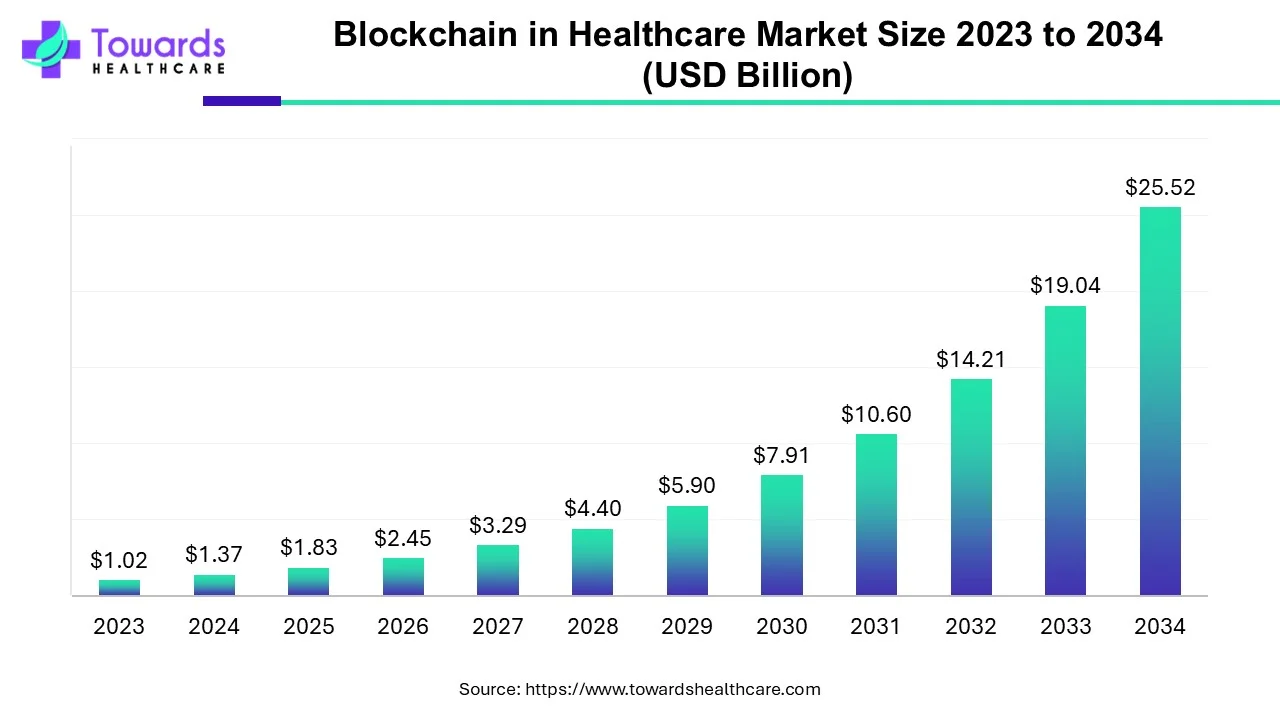
Blockchain Technology has the potential to develop an efficient, transparent, safe, and effective method of communicating data all over healthcare. A blockchain is described as a growing set of cryptographically linked records known as blocks. Each block includes a cryptographic hash of the previous block, as well as a time and date, and transaction data. The timestamp ensures that the transaction data is actually at the time the block was published and so may be hashed. Since each block carries information about the one that came before it, they form a chain, with each new block reinforcing the ones that came before it. As a result, blockchains are resistant to data change since data in any one block cannot be modified retrospectively without affecting all subsequent blocks once it has been recorded.
Blockchain technology has been used in the healthcare sector for numerous purposes. However, integrating artificial intelligence (AI) into blockchain technology makes it smart with enhanced performance. AI-enabled blockchain technologies can improve the impact on the medical domain, adding on multiple aspects such as analytics, diagnosis, medical report validation, and decision-making. AI and blockchain can help to manage and maintain electronic health records (EHR), improving interoperability. The large dataset can be analyzed using AI, enabling physicians to deliver tailored treatment to the patients. The growing demand for telemedicine and personalized medicine promotes the use of AI in blockchain technology. Moreover, AI-enabled blockchain technology helps to identify potential targets for drug delivery.
In the field of healthcare, the urgency of development is increasing at tremendous speed. Today, there is a demand for high-quality healthcare facilities that are backed by innovative and cutting-edge technology. Blockchain would play a major role in revolutionizing the healthcare sector in this case. Furthermore, the healthcare environment is shifting toward a patient-centered strategy that emphasizes two key aspects: accessible services and appropriate healthcare resources. Blockchain improves the ability of healthcare organizations to deliver enough patient care and high-quality health facilities. Another time-consuming and repetitive activity that contributes to high healthcare expenses may be resolved easily with this technology. Citizens can participate in health research initiatives using Blockchain technology.
The growing demand for telehealth presents numerous future opportunities for the market. The need for advanced healthcare services in remote areas, the rising adoption of the internet, advanced 5G technology, and the COVID-19 pandemic era increased the demand for telehealth. Blockchain technology enables decentralized, tamper-proof, traceable, immutable, auditable, and secure telehealth and telemedicine services. The latest innovations in the existing blockchain technology can aid in minimizing transaction processing time for telehealth, increasing its suitability for the healthcare sector. The high data security and privacy make private and consortium blockchain-based systems highly suitable for the digitization and automation of telehealth and telemedicine services.
Consumers have embraced telehealth, moving from 11% using it in 2019 to 76% who are now interested in using telehealth moving forward. This shift is driven by the need to avoid exposure to COVID-19, with over 70% of in-person visits being cancelled. Consumers are also increasingly likely to use telehealth going forward, with 76% of survey respondents indicating they are highly or moderately likely to use telehealth, and 74% of users reporting high satisfaction.
Providers have also rapidly adopted telehealth. To meet the increased demand, health systems, independent practices, and behavioral health providers have scaled their telehealth offerings to fill the gap left by cancelled in-person appointments. This shift is reflected in the number of telehealth visits, which has increased 50-175 times since before COVID-19. Providers also view telehealth more favorably (57%) and are more comfortable using it (64%) than they did before COVID-19.
The increasing implementation of blockchain as a service (BaaS) is likely to propel the blockchain in the healthcare market ahead. Blockchain technology has the potential to provide innovative solutions to the healthcare industry's challenges, such as supply chain management, smart contracts, the confidentiality of personal health information, technical issues in data management, the enablement of alternative payment models, and virus outbreak tracking.
Furthermore, the cost-effectiveness of Blockchain technology in healthcare is driving market expansion. Many firms have begun to leverage blockchain technology to address critical concerns in the healthcare industry, increasing the bar for security standards. The digital ledger system is incredibly secure, does not require a third-party administrator, and has a high level of transparency. Public blockchain technology has been built to work with the greatest medical data security standards, boosting the business's value. Furthermore, the low cost of using public blockchain technology in healthcare is a key driver driving business expansion. The high grade of security procedures, dependable portal services, and anonymous nature are predicted to favorably affect market demand.
Reluctance to Share Information, a lack of a centralized authority and a set of common standards, a lack of technological infrastructure, and a shortage of trained experts will be the primary barriers to the growth of the Global Blockchain In the Healthcare Market. The main issue with using this modern technology in medical institutions is a lack of expertise. Blockchain applications are still in their infancy stages and require further work for technological investigation and study. It does, however, apply to the responsibilities of health organizations and regulators.
Technological innovations are considerably altering the Blockchain in the Healthcare Market. As the need for blockchain technology grows, the leading players in the healthcare blockchain market are focused on providing sophisticated technological solutions for the healthcare industry in order to increase their market position.
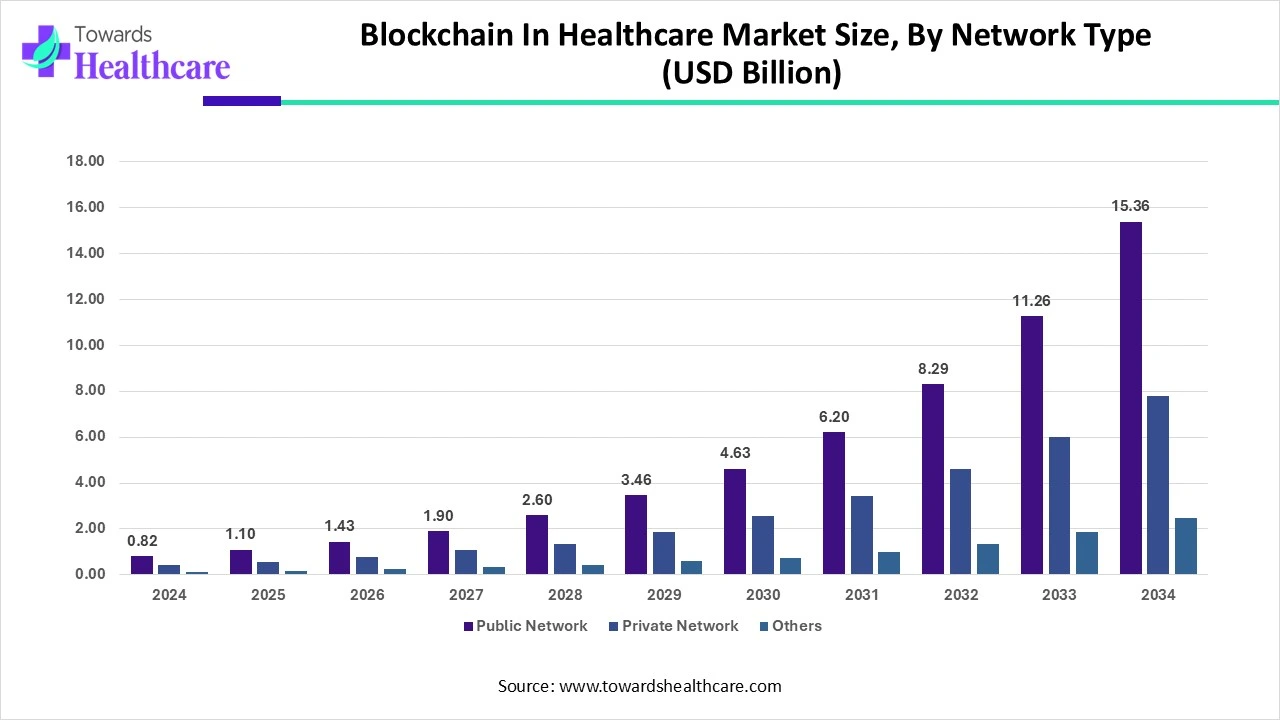
By network type, the private segment is anticipated to grow with the highest CAGR in the market during the studied years. The Private blockchain network is a decentralized ledger technology restricted to a specific group of participants. This helps to secure the data, eliminating the risk of data leaks. It requires permission for its access and is operative only in a closed network. This increases the trust of patients and healthcare professionals, introducing privacy and control. The data are secured with the use of cryptography.
In 2022, the public network segment dominated the global market by network type. The rising use of public networks for data management is the primary driver of the large share of the public segment. Ethereum, a public network, is currently one of the most widely used technologies in healthcare. It is also referred to as a "permissionless" blockchain technology. The main factors driving the growth of these public networks are low cost and access to a larger database.

By application, the clinical trials & eConsent segment is predicted to witness significant growth in the market over the forecast period. Complex clinical trials require advanced technologies for seamless operations. Integrating blockchain technology in clinical trials improves data security, transparency, and integrity. It strengthens trust in research outcomes and supports advancements in medical science, saving time for a lot of researchers and healthcare professionals.
In 2022, the supply chain management application category represented more than 23% of the blockchain technology market share in the healthcare market. Blockchain applications aid in the preservation of data integrity. Additionally, the technology assists pharmaceutical businesses in facilitating interoperability with the Internet of Things (IoT) devices. It also aids in the recruitment of clinical trial candidates and the regulation of the drug supply chain. Blockchain has the potential to revolutionize the healthcare industry by cutting operational costs, reducing data corruption, and optimizing healthcare processes. During the projection period, the clinical trials & eConsent segment are predicted to increase at a significant rate. Leveraging technology in clinical trials allows for more effective data management and security. The incorporation of blockchain technology enables clinicians to safely connect internally.

In 2022, by end-user, the medical device & biopharmaceutical companies’ segment had a market share of more than 47%. This is due to enormous R&D investments, the requirement to secure data interchange and interoperability, and the extensive data management performed by these organizations in pharmaceutical research and development areas. The growing use of technology for critical functions such as verifying the authenticity of returned drugs, counterfeit prevention, compliance with the pharmaceutical supply chain, transparency and traceability in clinical trials, and improving the reliability and quality of clinical trial data is expected to contribute to the segment's large share.
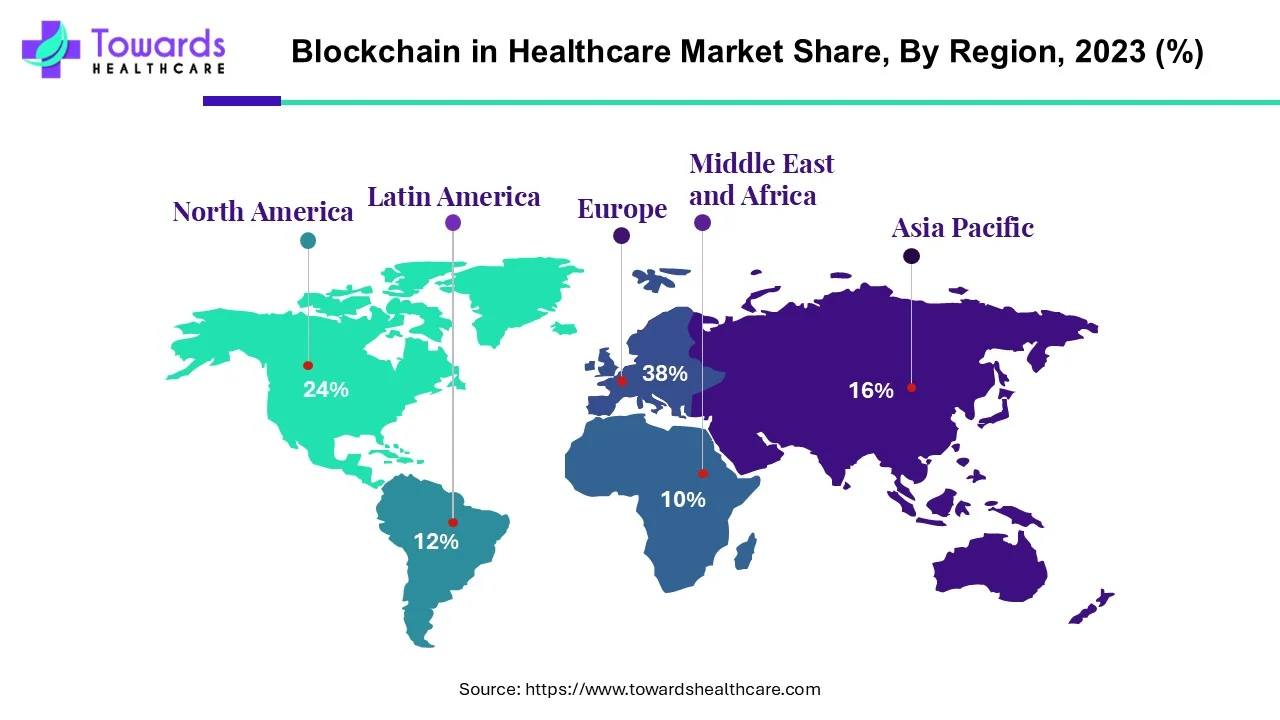
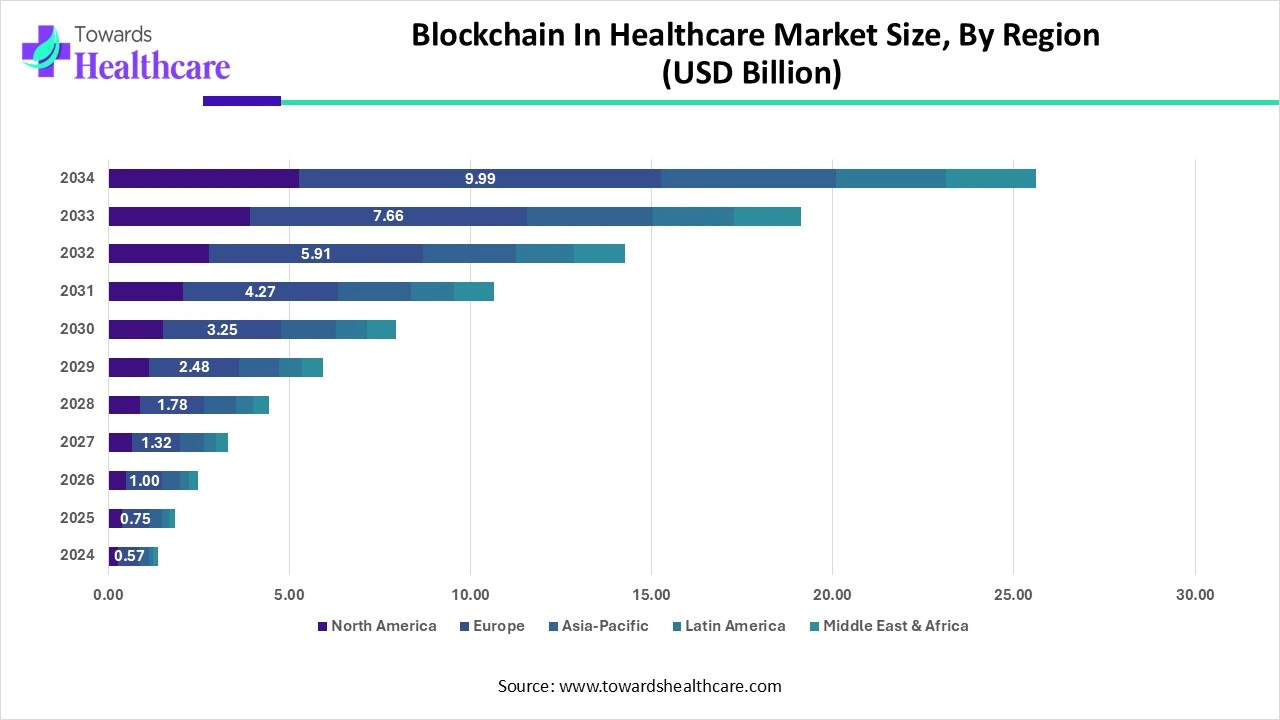
Due to different initiatives taken by regional governments to minimize data leaks, Europe held the largest market share of 38% in 2023. The rapidly expanding healthcare sector, rising adoption of advanced technologies, and favorable government policies drive the market. The European Commission published a recommendation on the development of EHR to facilitate citizen's access to their health information across all EU member states. This promoted the use of blockchain technology to drive innovation in EHR.
Additionally, the EU Blockchain Observatory and Forum is an initiative by the EU Government to accelerate blockchain innovation and cement Europe’s position as a global leader in this transformative new technology. Estonia is a pioneer in implementing blockchain technology at the national level and is a global leader.
The German market for blockchain technology in healthcare is experiencing rapid growth, owing to an increasing sensitivity to sensitive patient data and cyberattacks, and the demand for secure data storage and sharing solutions. This is further driven by the growing adoption of electronic health records, such as clinical trials, supply chain management, and telemedicine by spurring innovation and efficiency along with digital tools and the demand for seamless data sharing across platforms.
During the projected period, North America is expected to have the second-largest market share. The primary driver of regional growth is the rising demand for medical record security. The state-of-the-art healthcare infrastructure, increasing investments, and technological advancements drive the market. Countries like the US and Canada are at the forefront of using blockchain technology in the healthcare sector. The Canadian government invested $26.6 million from the Canadian Institutes of Health Research (CIHR) and partners to improve the health of people in Canada.
The U.S. market for blockchain technology in healthcare is experiencing substantial growth, driven by increasing data breaches, government mandates for medicine quality, and the higher demand for increased security and transparency. Blockchain is being used extensively in supply chain management by tracking and tracing pharmaceutical products to analyze quality and prevent counterfeiting. For instance, MedRec, a blockchain-based electronic medical record system, ensures patient data integrity and security by leveraging blockchain technology.
The Asia Pacific region is a notable hub for the Blockchain in Healthcare market due to rapid digital transformation, increasing investments in healthcare infrastructure, and a growing requirement for secure and transparent data management, specifically in clinical trials and drug discovery, by increasing the efficiency and integrity of the research process. Governments in the Asia Pacific region are rapidly recognizing the potential of blockchain technology and are actively reinforcing its development through policy shifts and strategic initiatives.
India is leveraging blockchain technology to improve its healthcare infrastructure by addressing challenges such as data security, interoperability, and counterfeit drugs by developing a secure and transparent system for storing and sharing Electronic Health Records. Furthermore, Government initiatives like the Ayushman Bharat Digital Mission aim to develop a national healthcare database for all citizens, and blockchain enables its enhancement its security and transparency.
Transparency In The Supply Chain: Using a blockchain-based system to monitor products from the point of manufacture and at each level of the supply chain provides customers with complete visibility and transparency of the goods they are purchasing.
E-Health Records Centered On The Patient: Every country and region's healthcare systems are dealing with the problem of data silos, which means that patients and their healthcare professionals have an incomplete understanding of their medical history.
Insurance And Supply Chain Settlements Using Smart Contracts: Pharmaceutical companies, medical device OEMs, wholesalers, insurers, and healthcare providers, for instance, can authenticate their identities as organizations, log contract details, and track transactions of goods and services, as well as payment settlement details for those goods and services, using blockchain-based systems provided by companies such as Chronicled and Curisium.
IoT Security For Remote Monitoring: One of the biggest trends in digital health is the adoption of remote monitoring solutions, where all kinds of sensors measuring patients’, vital signs are being used to help give healthcare practitioners more visibility into patients’ health, enabling more proactive and preventative care. We’ve previously covered many promising remote monitoring use cases in our articles on 5G and edge computing in digital health.
Remote Monitoring Of IoT Security: One of the most significant developments in digital health is the usage of remote monitoring systems, in which various sensors tracking patients' vital signs are utilized to provide healthcare practitioners with more insight into patients' health, allowing for more proactive and preventative care.
Blockchain technology can aid in the growth of the global healthcare business by saving money and encouraging further investment in critical resources. With so much at risk, it's difficult to believe that the current inefficient, highly bureaucratic, and failing healthcare business will continue. It is time for patients, practitioners, and executives to adopt the technological and system-based innovations at their disposal.
Sandeep Naliwal, Founder of Blockchain for Impact, commented on their strategic partnership with IIT Bombay that they have the opportunity to advance healthcare innovations that can positively impact public health on a massive scale. He also added that this partnership can support groundbreaking research projects and bring transformative solutions to communities across India and the Global South.
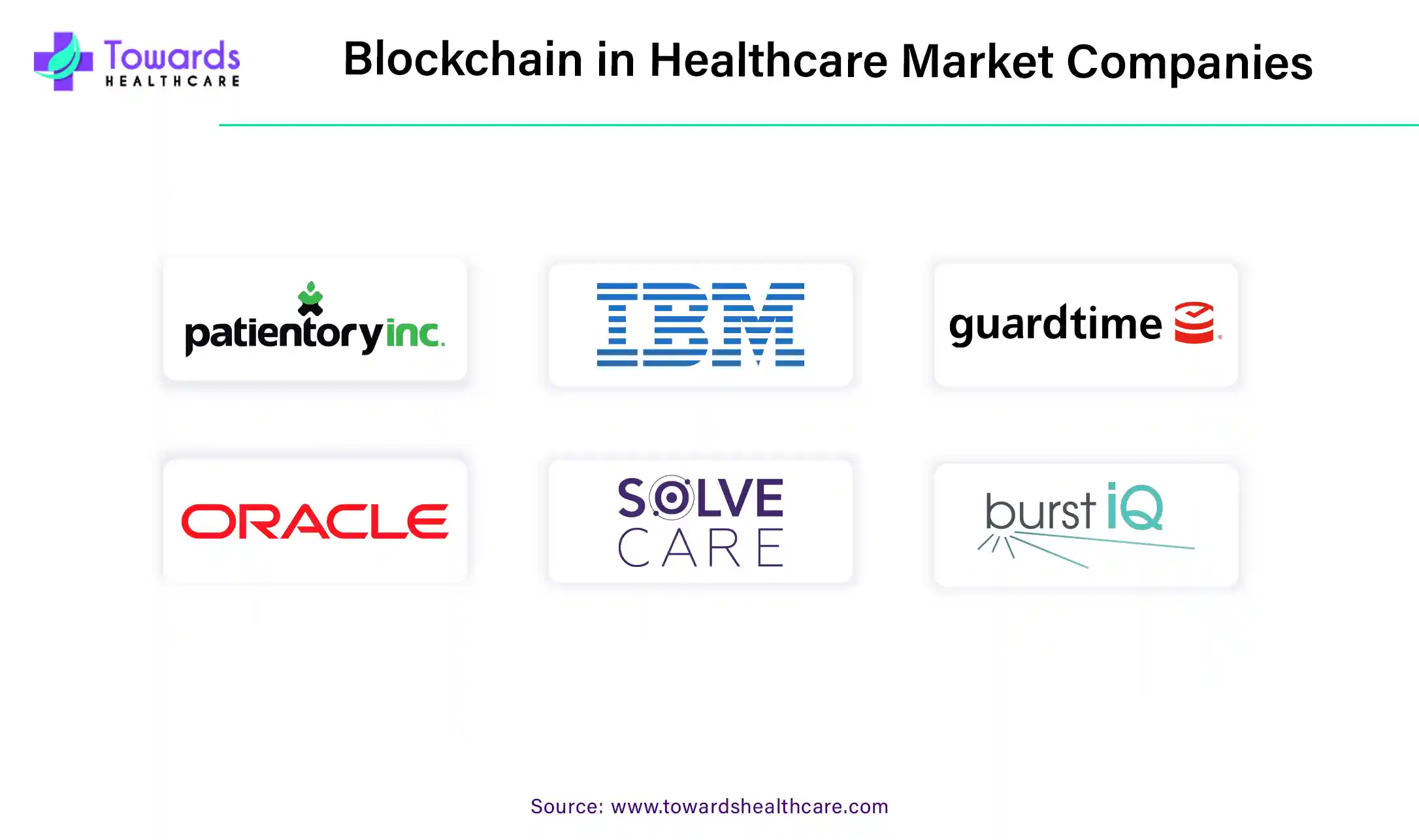
By Network Type
By Application
By End-User
By Region
December 2025
December 2025
December 2025
December 2025